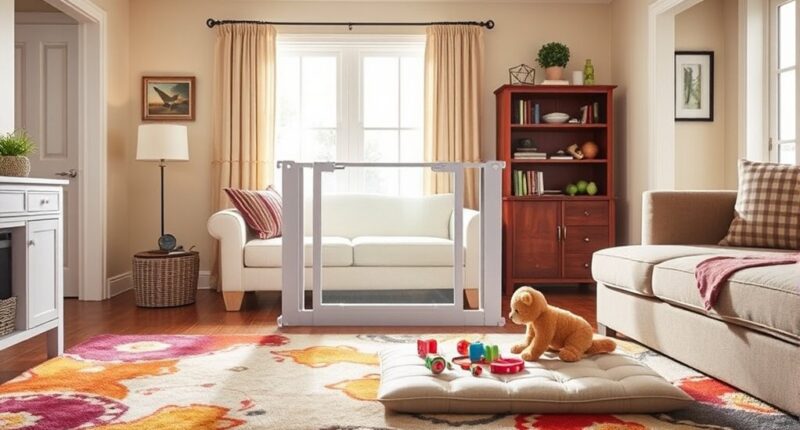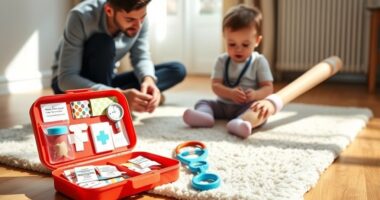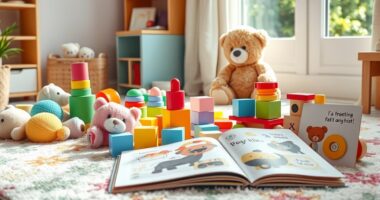To toddler-proof your home beyond basic baby gates, focus on securing decor, furniture, and toys. Choose sturdy, non-toxic items and anchor heavy furniture to walls. Keep small toys out of reach and regularly inspect items for damage. Use outlet covers, cordless window treatments, and padded furniture to minimize hazards. Maintain a clutter-free environment, and adapt safety measures as your child grows. Continue exploring to discover more ways to create a truly safe space for your toddler.
Key Takeaways
- Secure all furniture, shelves, and heavy decor to walls to prevent tipping hazards.
- Use outlet covers, cord organizers, and cordless window treatments to reduce strangulation risks.
- Choose non-toxic, sturdy toys and store small parts out of reach to prevent choking.
- Remove clutter and ensure walkways are clear to minimize tripping and falling dangers.
- Regularly inspect and maintain safety features, updating as your child’s abilities develop.

Childproofing your home is an essential step to keep your toddler safe as they become more curious and mobile. As your little one starts exploring every corner, it’s important to think beyond just installing baby gates. Creating a safe environment involves paying attention to details like nursery decor and toy safety, which often get overlooked. When choosing nursery decor, opt for items that are sturdy, non-toxic, and securely attached. Avoid decorative items with small parts that your toddler could swallow or choke on. Wall decals should be firmly fixed, and furniture should be anchored to the wall to prevent tipping. By selecting safe decor, you reduce the risk of accidents and create a calming, organized space where your child can explore freely without hazards.
Toy safety is another vital aspect of toddler-proofing. Always check that toys are age-appropriate, with no small pieces that could pose a choking hazard. Regularly inspect toys for damage—cracks, broken parts, or loose components can turn a fun plaything into a danger. When introducing new toys, look for labels indicating they meet safety standards, and avoid toys with sharp edges or toxic paint. Storage is key; keep small toys out of reach when not in use, and use bins or shelves that are sturdy and easy to access. Teaching your child to put toys away after playing not only keeps the space tidy but also reduces tripping hazards. Additionally, be mindful of how toys are stored in relation to furniture and other household items, ensuring they don’t create clutter that can trip or fall.
Beyond the obvious, toddler-proofing also involves considering your home’s decor and layout. For example, choose curtains or blinds without cords that could pose a strangulation risk. Cover electrical outlets with safety plugs, and keep cords from lamps or electronic devices out of reach. Furniture with sharp edges should be padded or replaced with rounded options. When it comes to decor, avoid heavy items that could fall or be pulled down, and secure picture frames or shelves to the wall. Regularly review and update your safety measures as your toddler grows and their abilities change. This proactive approach not only keeps your home safe but also encourages your child’s natural curiosity by providing a secure environment to learn and explore confidently. Additionally, understanding the importance of contrast ratio in your home setup can help you optimize lighting and visual comfort, creating a safer and more inviting space for your little one.
Frequently Asked Questions
How Can I Toddler-Proof Electrical Outlets Effectively?
To toddler-proof electrical outlets effectively, you should use childproof locks or outlet covers. These prevent your little one from inserting objects into the sockets. Install outlet covers that are safety-rated and tamper-resistant, ensuring they stay in place. Regularly check that the covers are secure and undamaged. By taking these steps, you create a safer environment, keeping your child protected from electrical hazards without sacrificing accessibility for adults.
What Are the Hidden Hazards in My Kitchen for Toddlers?
Did you know that kitchen accidents account for nearly 40% of home injuries in toddlers? In your kitchen, hidden hazards include unsecured appliances, hot surfaces, and small objects that can cause choking. To guarantee safety, focus on childproofing appliances and hazard identification, making sure dangerous items are out of reach and appliances are secured. Staying vigilant helps prevent accidents and keeps your little one safe from unseen dangers.
How Do I Secure Furniture to Prevent Tipping?
You should focus on furniture stability by using wall anchoring to prevent tipping. Secure heavy furniture like bookshelves, dressers, and cabinets to the wall with straps or brackets. Check that all anchors are properly installed and tight. Regularly inspect your furniture to guarantee the anchors remain secure. This simple step drastically reduces the risk of furniture tipping over when your toddler pulls or climbs, keeping your little one safe.
What Non-Toxic Materials Are Safest for Toddler-Proofing?
Did you know that children tend to explore with their mouths, increasing the importance of safe materials? You should opt for non-toxic paints and natural cleaning products to minimize risks. These materials are free from harmful chemicals, making your home safer for your toddler. Using non-toxic paints on furniture and natural cleaning products on surfaces guarantees a healthier environment. Your child’s safety depends on choosing the safest, non-toxic options available.
How Can I Create a Safe Outdoor Play Area?
You can create a safe outdoor play area by installing sturdy garden fencing to keep your toddler contained and prevent wandering. Add shaded play zones with umbrellas or pergolas to protect them from sun exposure. Regularly inspect the fencing for gaps or damage, clean the area of hazards, and select non-toxic outdoor toys. This setup guarantees your little one enjoys outdoor play safely and comfortably.
Conclusion
Think of your home as a castle, and your toddler as a curious explorer. Just like a castle needs sturdy walls and secret passages guarded, your space requires thoughtful toddler-proofing. When I childproofed my home, I discovered that small changes, like cabinet locks and corner protectors, transformed chaos into confidence. Remember, a safe home isn’t just about preventing accidents — it’s about giving your little adventurer the freedom to explore safely. Protect your castle, and let them thrive.









